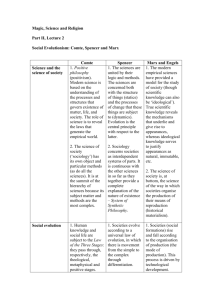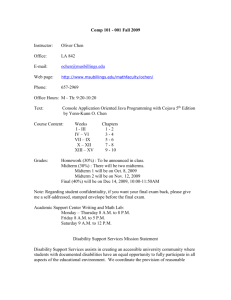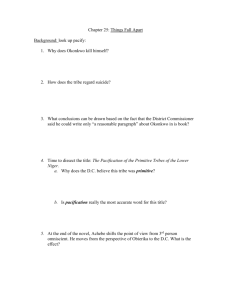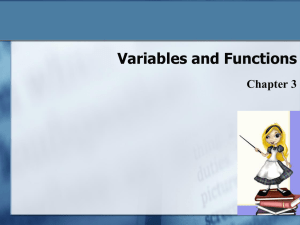The Design Process
advertisement
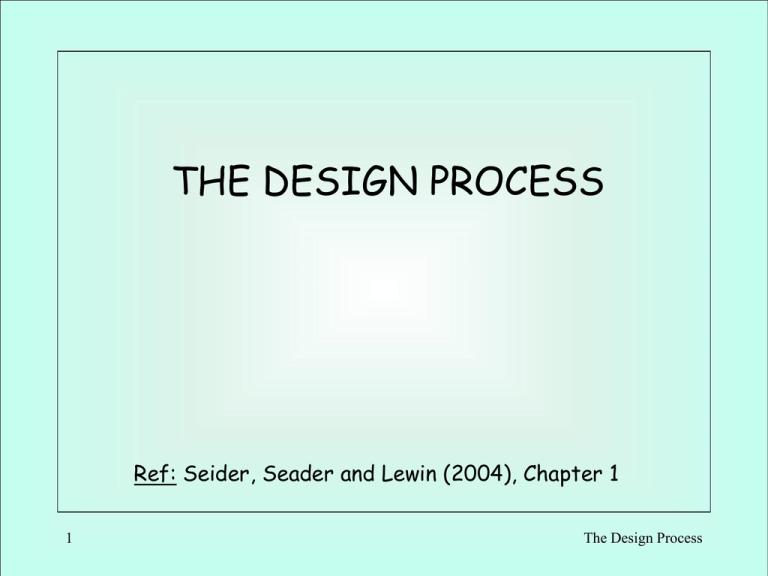
THE DESIGN PROCESS Ref: Seider, Seader and Lewin (2004), Chapter 1 1 The Design Process Schedule - The Design Process Primitive Design Problems – Example Steps in Designing and Retrofitting Chemical Processes – – – – – – – Assess Primitive Problem Process Creation Development of Base Case Detailed Process Synthesis - Algorithmic Methods Process Controllability Assessment Detailed Design, Sizing, Cost Estimation, Optimization Construction, Start-up and Operation Environmental Protection Safety Considerations 2 The Design Process Primitive Design Problems The design or retrofit of chemical processes begins with the desire to produce profitably chemicals that satisfy societal needs that arise in the broad spectrum of industries that employ chemical engineers: – – – – – petrochemicals, petroleum products industrial gases foods pharmaceuticals – – – – polymers coatings electronic materials bio-chemicals Partly due to the growing awareness of the public, many design projects involve the redesign, or retrofitting, of existing chemical processes to solve environmental problems and to adhere to stricter standards of safety 3 The Design Process Origins of Design Problems Often, design problems result from the explorations of chemists, biochemists, and engineers in research labs to satisfy the desires of customers to obtain chemicals with improved properties for many applications However, several well-known products, like Teflon (polytetrafluoroethylene), were discovered by accident. In other cases, an inexpensive source of a raw material(s) becomes available Other design problems originate when new markets are discovered, especially in developing countries Yet another source of design projects is the engineer himself, who often has a strong inclination that a new chemical or route to produce an existing chemical can be very profitable. 4 The Design Process Typical Primitive Design Problem Consider, the need to manufacture vinyl chloride (VC), H H C C Cl H A typical primitive problem statement is as follows: “An opportunity has arisen to satisfy a new demand for VC monomer (VCM), on the order of 800 million pounds per year, in a petrochemical complex on the Gulf Coast, given that an existing plant owned by the company produces onebillion pounds per year of this commodity chemical. Since VCM is an extremely toxic substance, it is recommended that all new facilities be designed carefully to satisfy governmental health and safety regulations.” 5 The Design Process Steps in Process Design and Retrofit Assess Primitive Problem Detailed Process Synthesis Algorithmic Methods Development of Base-case Plant-wide Controllability Assessment Detailed Design, Equipment sizing, Cap. Cost Estimation, Profitability Analysis, Optimization 6 The Design Process Steps in Process Design and Retrofit SECTION A Detailed Process Synthesis Algorithmic Methods Development of Base-case Assess Primitive Problem Plant-wide Controllability Assessment Detailed Design, Equipment sizing, Cap. Cost Estimation, Profitability Analysis, Optimization 7 The Design Process Steps in Process Design and Retrofit 8 The Design Process Assess Primitive Problem Process design begins with a primitive design problem that expresses the current situation and provides an opportunity to satisfy a societal need. Normally, the primitive problem is examined by a small design team, who begins to assess its possibilities, to refine the problem statement, and to generate more specific problems: – Raw materials - available in-house, can be purchased or need to be manufactured? – Scale of the process (based upon a preliminary assessment of the current production, projected market demand, and current and projected selling prices) – Location for the plant Refined through meetings with engineering technical management, business and marketing. Brainstorming to generate alternatives 9 The Design Process Example: VC Manufacture To satisfy the need for an additional 800 MMlb/yr of VCM, the following plausible alternatives might be generated: Alternative 1. A competitor’s plant, which produces 2 MMM lb/yr of VCM and is located about 100 miles away, might be expanded to produce the required amount, which would be shipped. In this case, the design team projects the purchase price and designs storage facilities. Alternative 2. Purchase and ship, by pipeline from a nearby plant, chlorine from the electrolysis of NaCl solution. React the chlorine with ethylene to produce the monomer and HCl as a byproduct. Alternative 3. Since the existing company produces HCl as a byproduct in large quantities are produced, HCl is normally available at low prices. Reactions of HCl with acetylene, or ethylene and oxygen, could produce 1,2-dichloroethane, an intermediate that can be cracked to produce vinyl chloride. 10 The Design Process Survey Literature Sources Stanford Research Institute (SRI) Design Reports Encyclopedias – Kirk-Othmer Encyclopedia of Chemical Technology (1991) – Ullman’s Encyclopedia of Industrial Chemistry (1988) – Encyclopedia of Chemical Processing and Design (McKetta and Cunningham, 1976) – ... Handbooks and Reference Books – Perry’s Chemical Engineers Handbook (1997) – CRC Handbook of Chemistry and Physics (1997) – ... Indexes – See Ferdowsi Library Patents (see web for example www.uspto.gov/patft) Internet 11 The Design Process Steps in Process Design and Retrofit Assess Primitive Problem Detailed Process Synthesis Algorithmic Methods Development of Base-case Plant-wide Controllability Assessment SECTION B Detailed Design, Equipment sizing, Cap. Cost Estimation, Profitability Analysis, Optimization 12 The Design Process Steps in Process Design and Retrofit 13 The Design Process Steps in Process Design and Retrofit Assess Primitive Problem Detailed Process Synthesis Algorithmic Methods Development of Base-case Detailed Design, Equipment sizing, Cap. Cost Estimation, Profitability Analysis, Optimization 14 Plant-wide Controllability Assessment SECTION C The Design Process Steps in Process Design and Retrofit 15 The Design Process Environmental Issues in Design Handling of toxic wastes – 97% of hazardous waste generation by the chemicals and nuclear industry is wastewater (1988 data). – In process design, it is essential that facilities be included to remove pollutants from waste-water streams. Reaction pathways to reduce by-product toxicity – As the reaction operations are determined, the toxicity of all of the chemicals, especially those recovered as byproducts, needs to be evaluated. – Pathways involving large quantities of toxic chemicals should be replaced by alternatives, except under unusual circumstances. Reducing and reusing wastes – Environmental concerns place even greater emphasis on recycling, not only for unreacted chemicals, but for product and by-product chemicals, as well. (i.e., production of segregated wastes - e.g., production of composite materials and polymers). 16 The Design Process Environmental Issues in Design (Cont’d) Avoiding non-routine events – Reduce the likelihood of accidents and spills through the reduction of transient phenomena, relying on operation at the nominal steady-state, with reliable controllers and faultdetection systems. Design objectives, constraints and optimization – Environmental goals often not well defined because economic objective functions involve profitability measures, whereas the value of reduced pollution is often not easily quntified economically. – Solutions: mixed objective function (“price of reduced pollution”), or express environmental goal as “soft” or “hard” constraints. – Environmental regulations = constraints 17 The Design Process Safety Considerations Example Disaster 1 – Flixborough: 1st June 1974 http://www.hse.gov.uk/hid/land/comah/level3/5a591f6.htm – 50 tons of cyclohexane were released from Nypro’s KA plant (oxidation of cyclohexane) leading to release of vapor cloud and its detonation. Total loss of plant and death of 28 plant personnel. – Highly reactive system - conversions low, with large inventory in plant. Process involved six, 20 ton stirred-tank reactors. – Discharge caused by failure of temporary pipe installed to replace cracked reactor. – The so-called “dog-leg” was not able to contain the operating conditions of the process (10 bar, 150 oC) 18 The Design Process Safety Considerations Flixborough - What can we learn? – Develop processes with low inventory, especially of flashing fluids (“what you don’t have, can’t leak”) – Before modifying process, carry out a systematic search for possible cause of problem. – Carry out HAZOP analysis – Construct modifications to same standard as original plant. – Use blast-resistant control rooms and buildings T. Kletz, “Learning from Accidents”, 2nd Ed. (1994) 19 The Design Process Safety Considerations (Cont’d) Example Disaster 2 – Bhopal: 3rd December 1984 http://www.bhopal.com/chrono.htm – Water leakage into MIC (Methyl isocyanate) storage tank leading to boiling and release of 25 tons of toxic MIC vapor, killing more than 3,800 civilians, and injuring tens of thousands more. – MIC vapor released because the refrigeration system intended to cool the storage tank holding 100 tons of MIC had been shut down, the scrubber was not immediately available, and the flare was not in operation. Bhopal - What can we learn? – Avoid use of hazardous materials. Minimize stocks of hazardous materials (“what you don’t have, can’t leak”). – Carry out HAZOP analysis. – Train operators not to ignore unusual readings. – Keep protective equipment in working order. – Control building near major hazards. 20 The Design Process Safety Issues: Fires and Explosions Flammability Limits of Liquids and Gases LFL and UFL (vol %) in Air at 25 oC and 1 Atm Compound LFL (%) UFL (%) Acetylene 2.5 100 Cyclohexane 1.3 8 Ethylene 2.7 36 Gasoline 1.4 7.6 Hydrogen 4.0 75 These limits can be extended for mixtures, and for elevated temperatures and pressures (see Seider et al, 2004). With this kind of information, the process designer makes sure that flammable mixtures do not exist in the process during startup, steady-state operation, or shut-down. 21 The Design Process The Design Process - Summary Steps in Designing and Retrofitting Chemical Processes – Assess Assess Primitive Problem Primitive Problem - covered today – Process Process Creation Creation – – – – – - next week Development of Base Case Detailed Process Synthesis - Algorithmic Methods Process Controllability Assessment Detailed Design, Sizing, Cost Estimation, Optimization Construction, Start-up and Operation Environmental Protection – Environmental regulations design constraints Safety Considerations – Should strive to design for “inherently safe plants” 22 The Design Process

